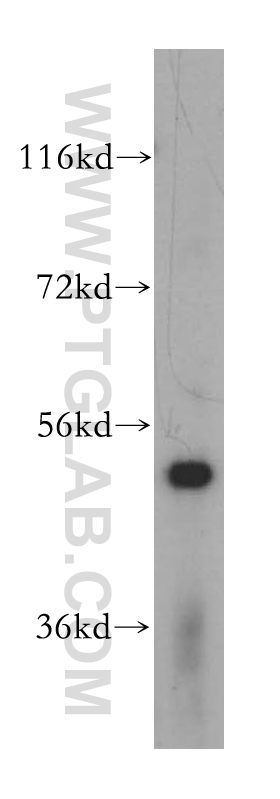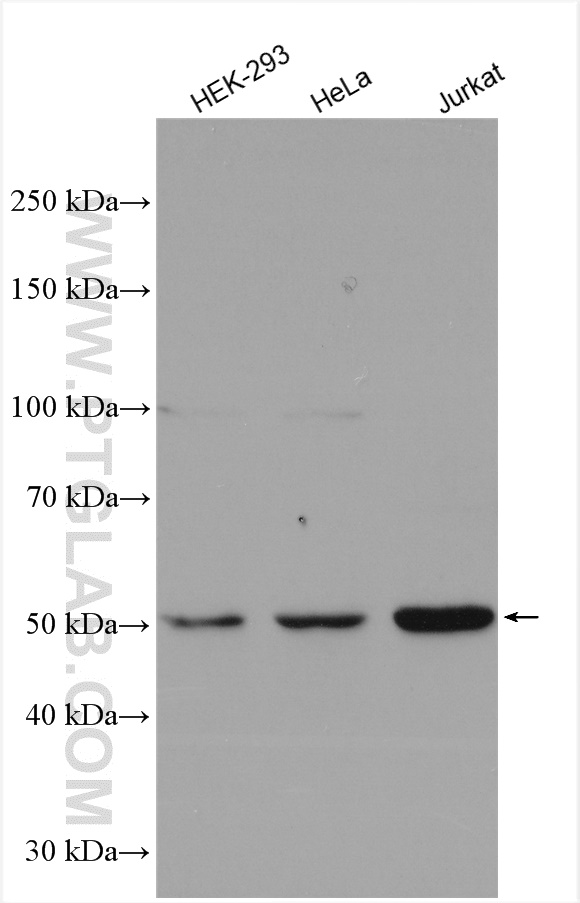PUS3 Polyclonal antibody
PUS3 Polyclonal Antibody for WB, ELISA
Host / Isotype
Rabbit / IgG
Reactivity
human, mouse, rat
Applications
WB, ELISA and More (1)
Conjugate
Unconjugated
验证数据展示
经过测试的应用
| Positive WB detected in | A549 cells, HEK-293 cells, HeLa cells, Jurkat cells |
推荐稀释比
| Application | Dilution |
|---|---|
| Western Blot (WB) | WB : 1:500-1:2000 |
| It is recommended that this reagent should be titrated in each testing system to obtain optimal results. | |
| Sample-dependent, Check data in validation data gallery. | |
发表文章中的应用
| WB | See 1 publications below |
| IHC | See 1 publications below |
产品信息
17248-1-AP targets PUS3 in WB, IHC, ELISA applications and shows reactivity with human, mouse, rat samples.
| Tested Applications | WB, ELISA Application Description |
| Cited Applications | WB, IHC |
| Tested Reactivity | human, mouse, rat |
| Cited Reactivity | human |
| Immunogen | PUS3 fusion protein Ag9983 种属同源性预测 |
| Host / Isotype | Rabbit / IgG |
| Class | Polyclonal |
| Type | Antibody |
| Full Name | pseudouridylate synthase 3 |
| Synonyms | 2610020J05Rik, FKSG32, pseudouridylate synthase 3, PUS3, tRNA pseudouridine synthase 3, tRNA uridine isomerase 3 |
| Calculated Molecular Weight | 56 kDa |
| Observed Molecular Weight | 50-52 kDa |
| GenBank Accession Number | BC004822 |
| Gene Symbol | PUS3 |
| Gene ID (NCBI) | 83480 |
| RRID | AB_2237874 |
| Conjugate | Unconjugated |
| Form | Liquid |
| Purification Method | Antigen affinity purification |
| UNIPROT ID | Q9BZE2 |
| Storage Buffer | PBS with 0.02% sodium azide and 50% glycerol pH 7.3. |
| Storage Conditions | Store at -20°C. Stable for one year after shipment. Aliquoting is unnecessary for -20oC storage. |
实验方案
| Product Specific Protocols | |
|---|---|
| WB protocol for PUS3 antibody 17248-1-AP | Download protocol |
| Standard Protocols | |
|---|---|
| Click here to view our Standard Protocols |
发表文章
| Species | Application | Title |
|---|---|---|
iScience RNA modification-related genes illuminate prognostic signature and mechanism in esophageal squamous cell carcinoma | ||
Anal Chem Targeted Quantitative Profiling of Epitranscriptomic Reader, Writer, and Eraser Proteins Using Stable Isotope-Labeled Peptides |

